Brisbane median house prices surpass $900k for the first time in history
Brisbane’s property price growth throughout March has re-accelerated across both the house and unit markets. Buyer activity has been strong, and competition for quality houses, units and townhouses has been fierce in recent months.

Brisbane has experienced 13 straight months of positive dwelling price growth, and the rate of price acceleration continues to outperform the national average. The house market in Brisbane is also outperforming the national average, but the unit market is the standout, with unit values in Brisbane performing three to four times better than the national average.
To continue reading the rest of this article, please log in.
Create free account to get unlimited news articles and more!
Last month, the data confirmed that while the month-on-month growth in Brisbane property was still positive, the rate of the price escalation was easing. However, March data demonstrated a further uplift in the rate of growth over the previous month.
There has been some reprieve for buyers over the last four weeks, with new listings coming to the market within the last 28 days increasing 9.5 per cent throughout March, according to SQM Research, compared to the month prior. This has provided buyers with a little more choice in terms of what to buy. New listings in Brisbane throughout March 2024 were 12.7 per cent higher, compared to March 2023, again providing some relief for the pent-up demand that has been building across many market segments in Brisbane.
Looking at total listing volumes in Brisbane, there is still a shortage of properties available, with a reduction of 11.1 per cent year-on-year. Keeping with the seasonal trend that occurs most years, the total volume of listings throughout March in Brisbane was higher than February, with 11.1 per cent more properties in total for buyers to consider.
CoreLogic auction data showed that the average auction clearance rate across Brisbane throughout March was 64.7 per cent. According to Apollo Auctions, Brisbane saw an average of 3.7 registered bidders per auction in March, compared to four registered bidders per auction throughout February. Additionally, the number of registered bidders who actively participated in each auction throughout March jumped to 60.8 per cent, up from 56.03 per cent in February. This confirms that buyer activity in the market remains strong with a heavy imbalance between supply and demand, in favour of sellers. While these conditions exist, buyer competition will remain elevated, and prices will continue to escalate.
Brisbane dwelling values
Dwelling values increased 1.1 per cent in Brisbane throughout March, up from 0.9 per cent in February. The quarterly change escalated slightly to 3 per cent, up from 2.9 per cent in the three months to February.
The median value for a dwelling in Greater Brisbane is now $817,564, which is a new record high for Brisbane. This is also $11,971 more than last month, and has surpassed the $800,000 mark. It is currently $805,593, which is $8,775 more than last month and $30,347 more than three months ago.
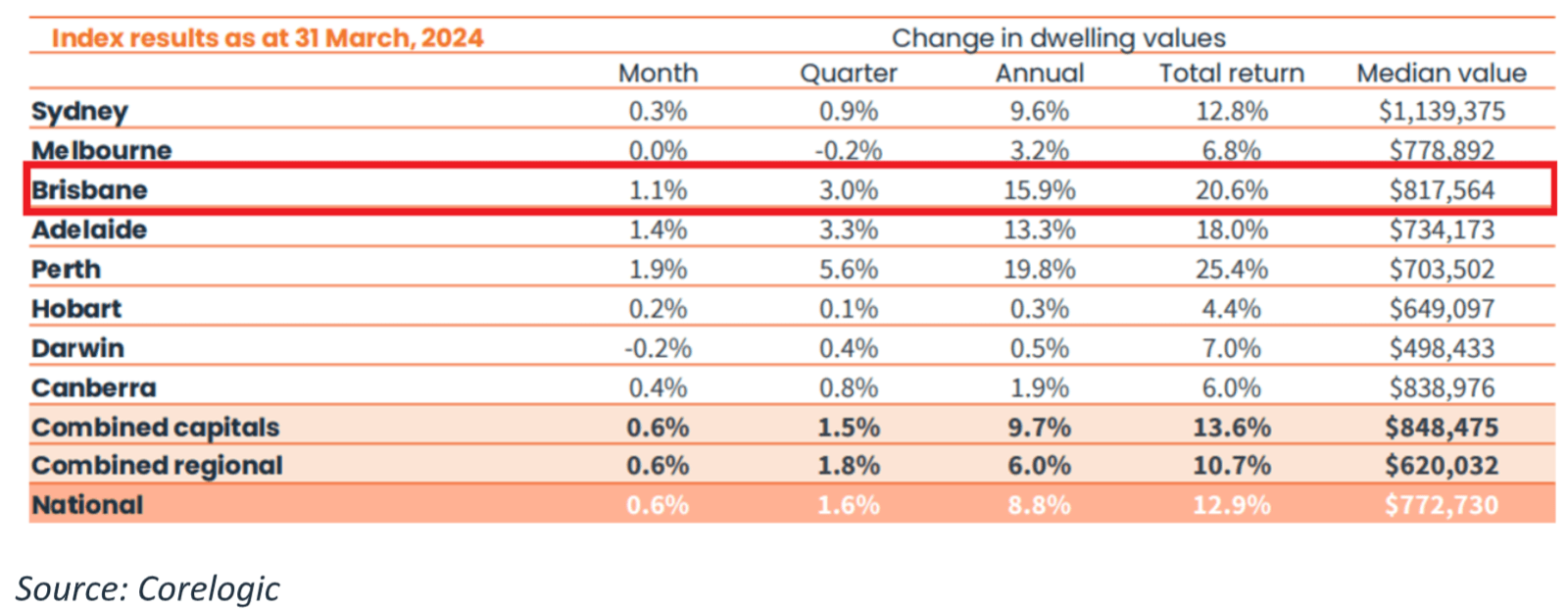
The median value of a dwelling in Brisbane continues to escalate above the median value for Melbourne and is approaching Canberra’s median dwelling value. This is despite the fact that median values for both houses and units throughout Brisbane remain lower than those in Melbourne. Compared to Canberra, Brisbane’s median house values are still much lower, however, for the first time, median unit values in Brisbane have surged above those in Canberra. The compositional bias of dwelling types within each city skews the dwellings data, so it’s important to understand the data by property type when assessing which city is actually more affordable.
The segmentation of dwelling value growth in Brisbane shows that the top end of the market has slowed down more than the middle and bottom end of the market in the three months up to the end of February 2024, compared to months prior.
Properties that make up the lowest 25 per cent of dwelling values have grown 3.8 per cent over the three months to 28 February, down from 4 per cent over the three months to the end of January. The middle 50 per cent of property values are now tracking at a quarterly change of 3.2 per cent, down from 3.4 per cent the month prior. And the top 25 per cent of property values have grown 2.3 per cent over the last quarter, compared to 2.8 per cent one month prior. This data confirms that the price deceleration is happening at a faster rate among the more expensive properties throughout Brisbane.
As the unit market continues to outperform the housing market in terms of monthly and quarterly price growth, the contribution that units would be making to the lowest 25 per cent of dwelling value growth throughout the city cannot be underestimated.
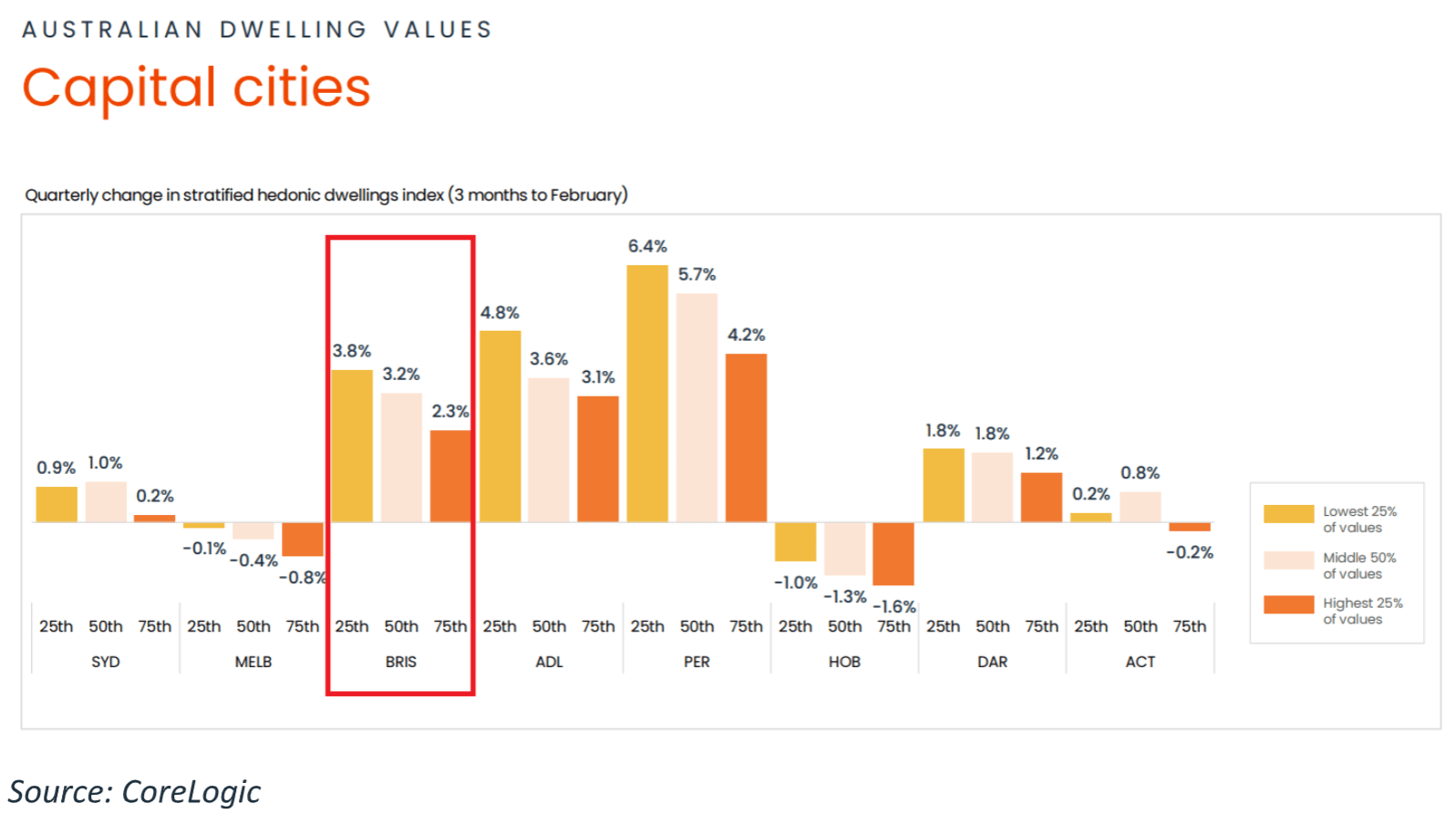
PropTrack dwellings data also confirmed that Brisbane experienced positive growth throughout March 2024, with price growth performance within Brisbane exceeding the national and capital city average for the last month and the past year as a whole.
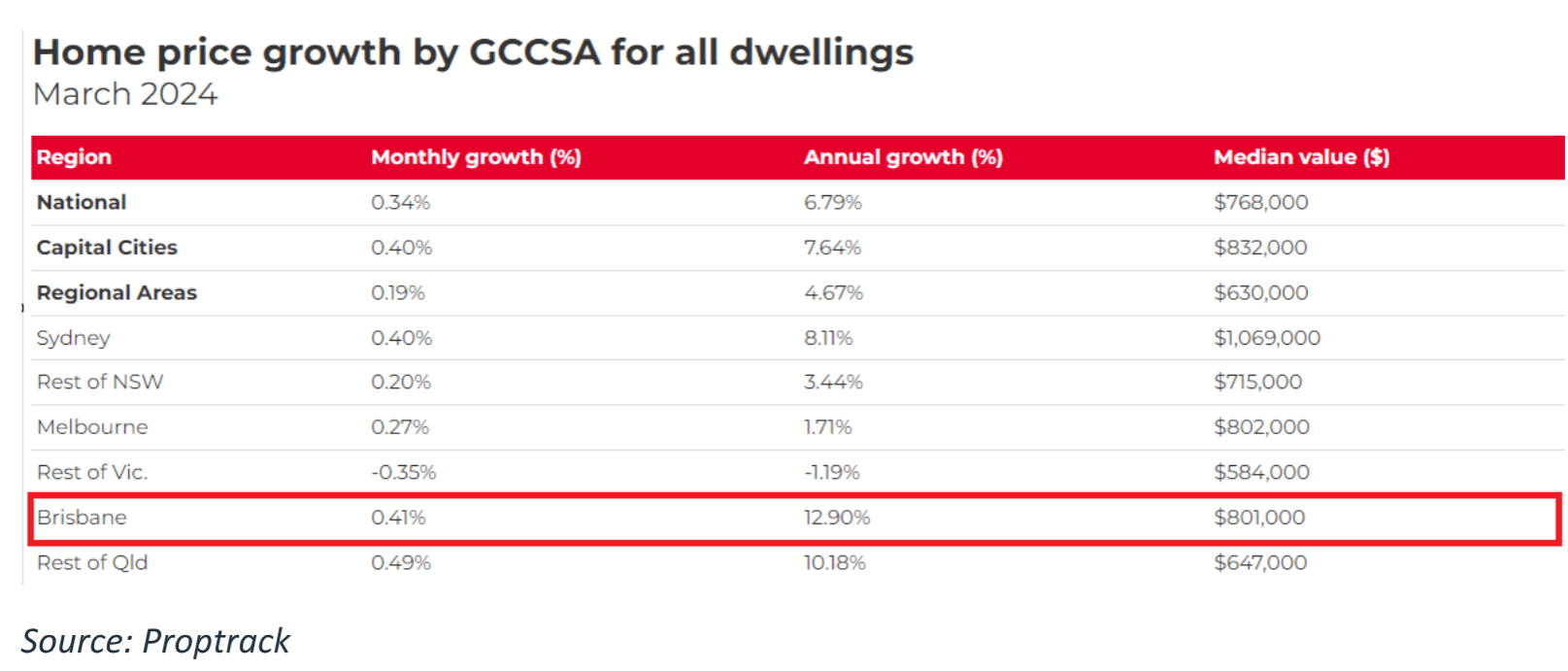
House prices in Brisbane
The median house price in Brisbane increased 1 per cent in March, up slightly from 0.9 per cent in February. Over the last three months house prices have grown 2.8 per cent, which is the same quarterly growth rate as last month. This indicates that the growth trajectory has been fairly consistent in Brisbane’s housing market for the last four months.
The median house price in Brisbane has, for the first time in history, surpassed the $900,000 mark, with CoreLogic confirming it as $909,988 at the end of March. This value is $10,514 more than last month and $33,997 more than three months ago. Brisbane remains the fourth most expensive capital city market based on house values behind Sydney, Canberra and Melbourne.
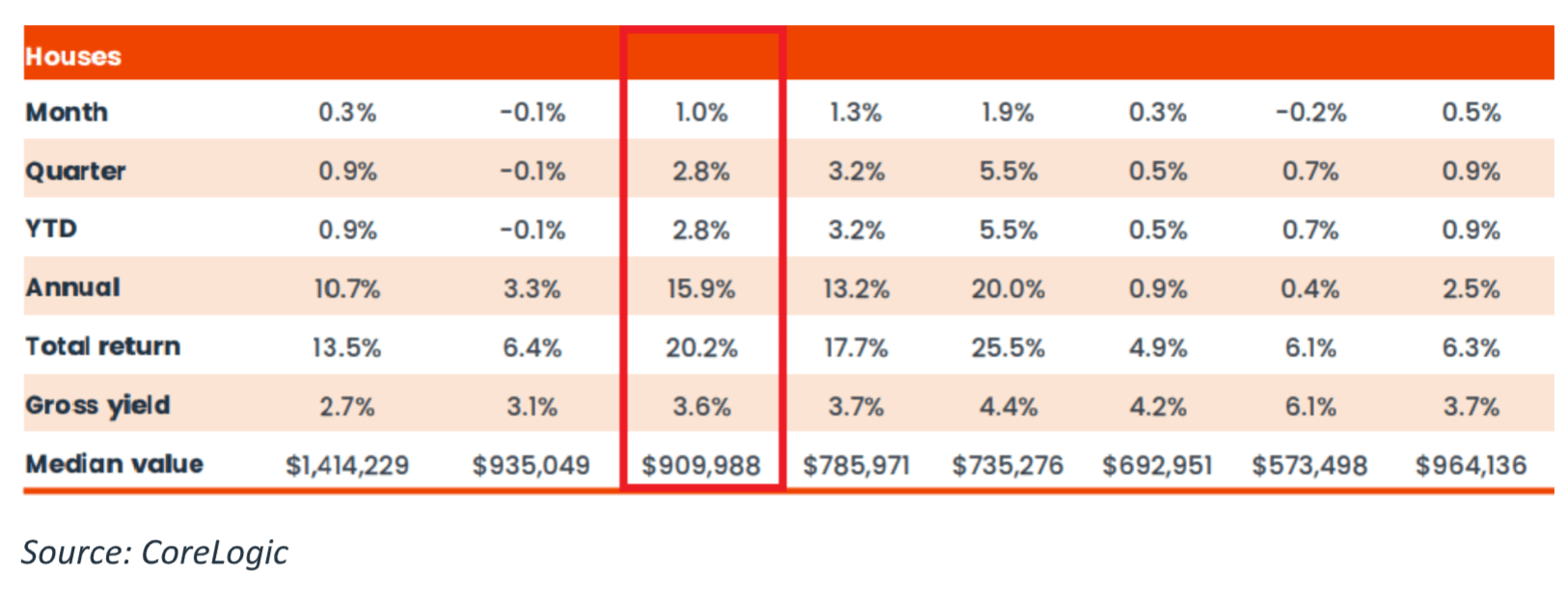
PropTrack data also confirmed house prices in Brisbane showed positive growth throughout March.
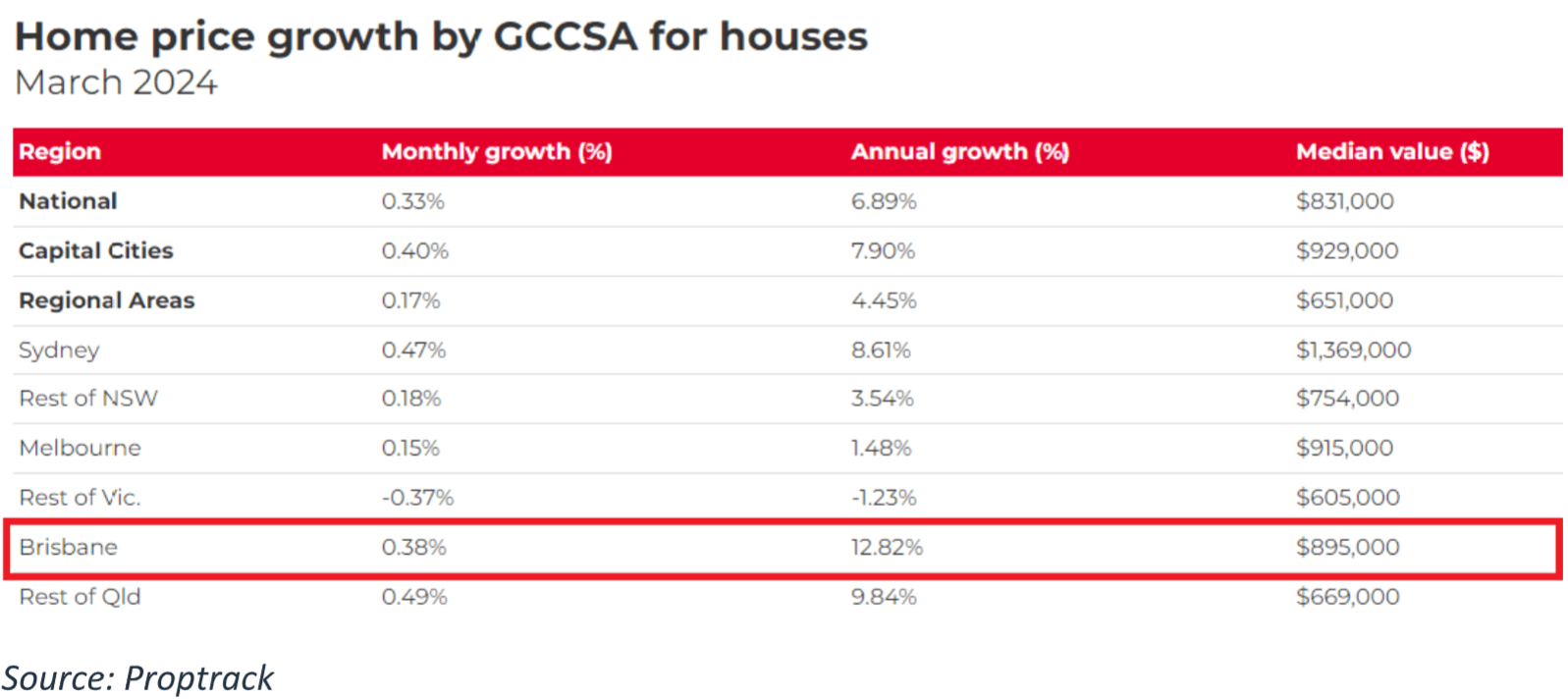
Unit prices in Brisbane
Median unit values in Brisbane jumped again in March, increasing 1.5 per cent throughout the month. Quarterly growth for units in Brisbane continues to accelerate with a 4.1 per cent increase over the last three months, compared to 3.6 per cent quarterly growth last month and 3.2 per cent the month prior.
The median value of a unit in Greater Brisbane is now $587,793, which is $11,434 more than last month and $26,777 more than three months ago. The unit segment of the market in Brisbane is now outperforming the house market in Brisbane based on the CoreLogic data for the last month, quarter and 12-month period.
With Brisbane’s median unit values having moved ahead of Canberra’s this month, Brisbane is now the third most expensive capital city market for buying a unit in Australia, ranking behind Sydney and Melbourne in median unit values.
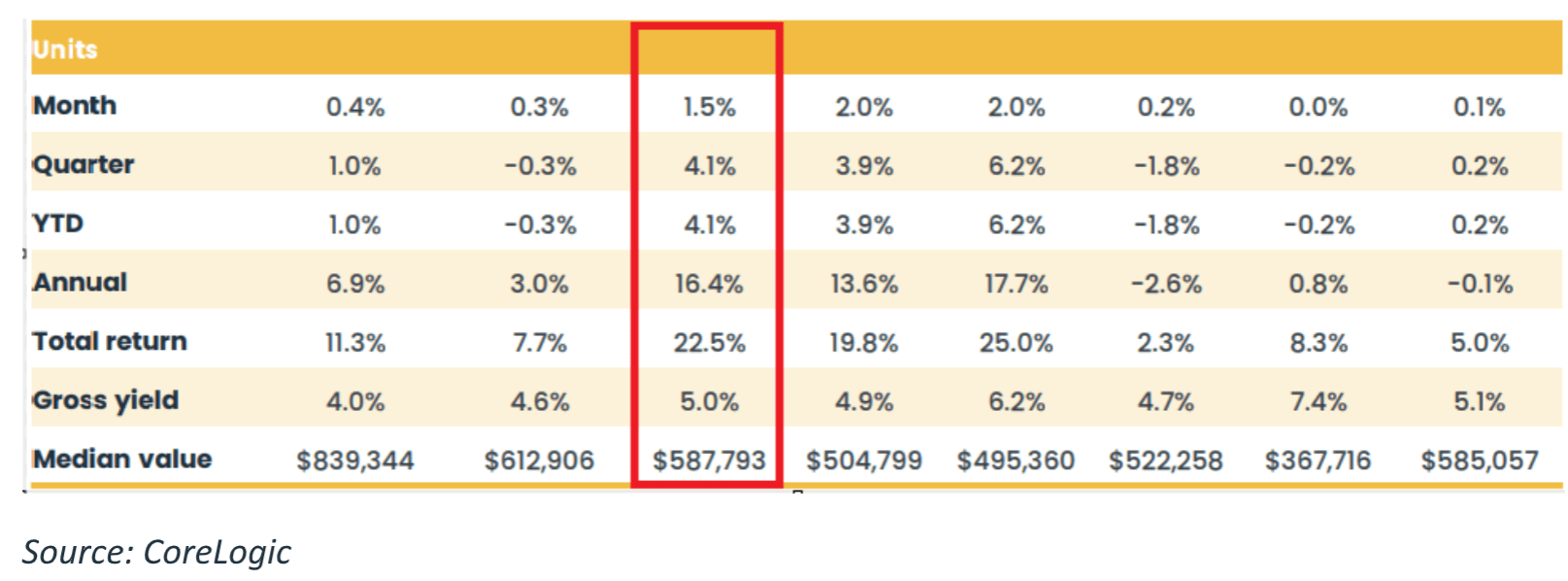
PropTrack data also confirmed the same trend for unit growth in Brisbane and showed that Brisbane’s unit growth performance is better than the national and capital city average on both a monthly and annual basis.
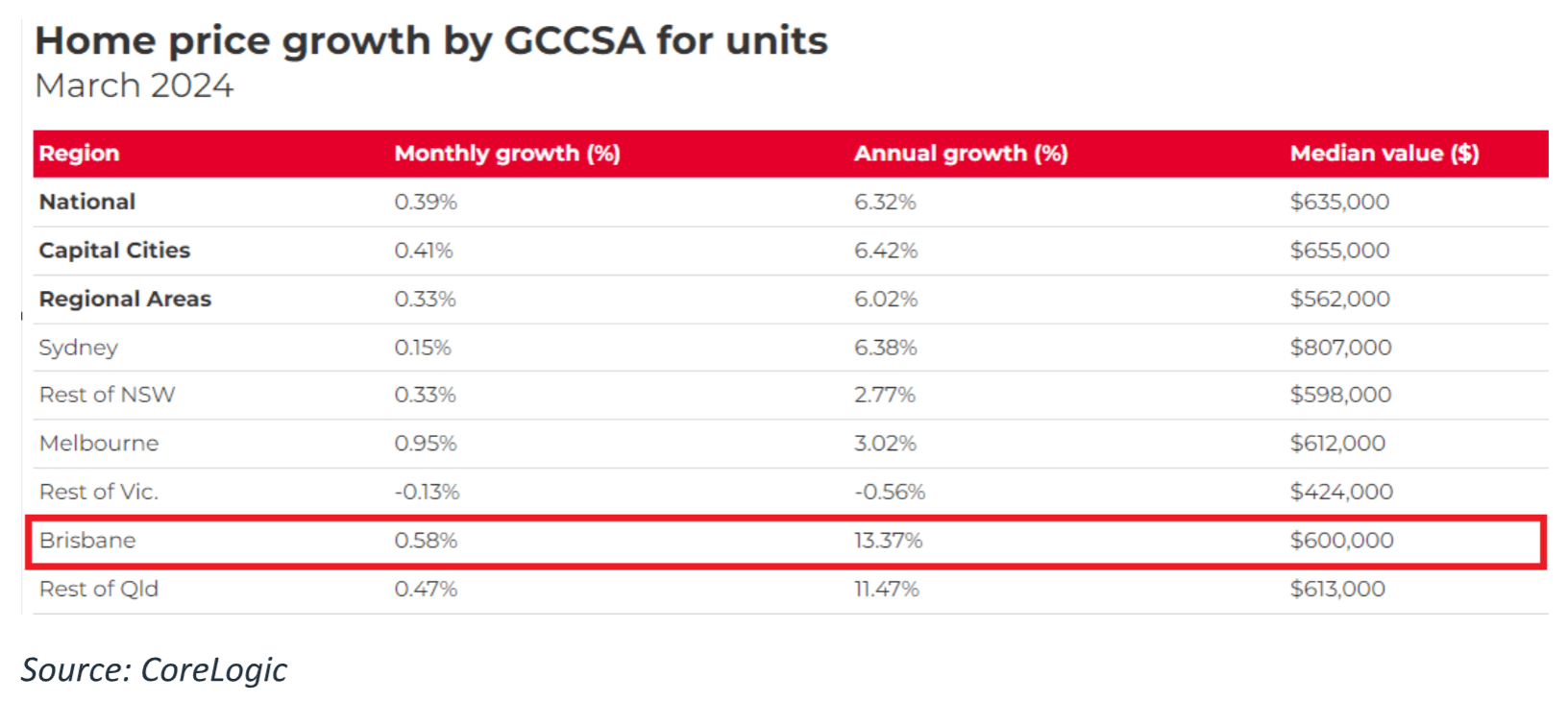
The rental market in Brisbane
Rental market conditions in Brisbane tightened further last month, with vacancy rates contracting from 1 per cent in January to 0.9 per cent in February, according to SQM Research.
House rents have increased 7.6 per cent in Brisbane over the last 12 months. This annual rate of growth has been slowly increasing again since January this year, indicating that tenants are continuing to experience difficulty in securing a property due to supply shortage, which is continuing to cause rents to rise.
Unit rents are up 11.2 per cent over the 12 months up until the end of March. The rate of growth in unit rents has eased slightly over the last three months, although growth in unit rents is still well ahead of growth in house rents throughout Brisbane.
Gross yields in Brisbane are currently 3.6 per cent for houses, and 5 per cent for units.

Summary
During March, it was encouraging to see more properties being listed for sale throughout Brisbane. With the rate at which a lot of properties are selling, many buyers are still facing a fast-paced market with high competition. Multiple offer sales have become the norm for high-quality properties. It’s not uncommon for agents to receive in excess of 10 offers on a single property, and this is especially true for well-positioned affordable unit and townhouse stock.
There has been a large slowdown across the city in construction, which means the demand for housing has been more concentrated on existing properties, rather than newly constructed homes or higher density dwellings. This is unlikely to change in the foreseeable future as many developers face tighter margins in an environment of higher site acquisition costs, escalating construction costs and higher interest rates.
The migration surge to Brisbane has put pressure on all segments of the market as those who have relocated also need somewhere to call home. This has increased the demand for property in both the rental and sales markets.
There won’t be much change in the months ahead. It is expected that supply constraints will remain in place and demand pressure will continue.
Of course, there will always be markets within markets, and Brisbane as a city doesn’t move as a whole, so understanding at a local level what properties are more desirable than others, and why some properties sell quickly, while others may not, is always important. Brisbane is likely to continue to experience positive price growth in the months ahead, but it is expected that variations in performance, based on different regions and different property types, will continue.

